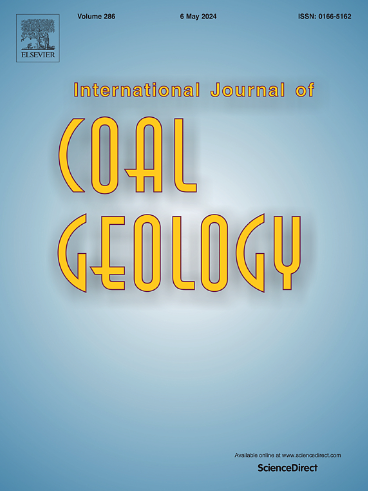Organic modes of occurrence and evolution mechanism of germanium and lithium in coal: Insights from density functional theory
IF 5.7
2区 工程技术
Q2 ENERGY & FUELS
引用次数: 0
Abstract
Critical elements in coal, such as Ge and Li, recently have attracted attention due to their economic significance. Modes of occurrence of these critical elements are academically and practically important, because they can not only provide evidence for sources of elements and minerals in coal and regional geological background information, but also help with design of recovery methods. However, conventional analytical methods are unable to observe precisely the organic binding sites of Ge and Li in coal, and this limits the understanding of their enrichment mechanism and the improvements for recovery techniques. In this study, organic modes of occurrence and evolution mechanism of Ge4+ and Li+ were investigated at the atom level by constructing molecular models of Ge- and Li-rich coals combined with density functional theory (DFT) methods. The solid-state 13C nuclear magnetic resonance spectroscopy (NMR), X-ray photoelectron spectroscopy (XPS), Fourier transform infrared spectroscopy (FTIR), and helium pycnometry analyses indicate that the molecular formulas of Ge- and Li-rich coals are C166H162N2O32 and C153H174N2O24S, respectively. The DFT analysis reveals that the binding sites for Ge4+ in Ge-rich coal are located near the carboxyl group (-COOH) and the pyrrole ring, while those for Li+ in Li-rich coal are near the carbonyl group (-C=O) and the pyrrole ring. The Ge4+ is immobilized in the Ge-rich coal molecular model through coordination bonds with the O atom in the -COOH and the C atom in the pyrrole ring, while being away from the N atom in the pyrrole ring. Li+ forms a coordination bond with the O atom in the -C=O and additional coordination bond with the nearby hydroxyl group during binding to the pyrrole ring. The impact of coal rank on the organic modes of occurrence of Ge4+ and Li+ was investigated using Wender coals of different ranks, which were one of the earliest proposed coal models. At the lignite stage, oxygen-containing functional groups and aromatic rings show a strong binding ability to Ge4+ and Li+, facilitating their enrichment in coals. Along with coal rank advance to bituminous coal, the reduction of oxygen-containing functional groups (e.g., -COOH and -C=O) and the relatively low condensation of aromatic rings decrease binding sites for Ge4+ and Li+, and the binding ability also decline, resulting in a decrease in their concentration. In anthracite stage, highly condensed aromatic rings provide binding sites for Ge4+ and Li+. The strong binding ability of aromatic rings to Ge4+ indicates that it is probably enriched in anthracite, whereas Li+ is difficult to enrich owing to its relatively weak binding ability to aromatic rings. The low content of oxygen-containing functional groups in anthracite reduces their effect on the organic modes of occurrence of Ge4+ and Li+. This study elucidates the organic modes of occurrence and evolution mechanism of Ge4+ and Li+ from the perspective of coal structure, providing fundamental insights for future research on the interaction between organic and inorganic matter within coal.
煤中锗、锂的有机赋存方式及演化机制:来自密度泛函理论的启示
煤中的关键元素,如锗和锂,由于其经济意义,最近引起了人们的关注。这些关键元素的赋存模式不仅可以为煤中元素矿物的来源和区域地质背景信息提供依据,而且有助于设计开采方法,具有重要的理论意义和现实意义。然而,传统的分析方法无法精确观察煤中Ge和Li的有机结合位点,这限制了对它们富集机理的认识和回收技术的改进。本研究结合密度泛函理论(DFT)方法,通过构建富Ge和富Li煤的分子模型,在原子水平上研究了Ge4+和Li+的有机发生模式和演化机制。固体13C核磁共振谱(NMR)、x射线光电子能谱(XPS)、傅里叶变换红外光谱(FTIR)和氦比谱分析表明,富Ge煤和富li煤的分子式分别为C166H162N2O32和C153H174N2O24S。DFT分析表明,富锗煤中Ge4+的结合位点位于羧基(-COOH)和吡咯环附近,富锂煤中Li+的结合位点位于羰基(-C=O)和吡咯环附近。Ge4+通过与-COOH中的O原子和吡咯环中的C原子的配位键固定在富锗煤分子模型中,而远离吡咯环中的N原子。Li+在与吡咯环结合的过程中与-C=O中的O原子形成配位键,并与附近的羟基形成额外的配位键。采用最早提出的温德煤(Wender coal)赋存模式之一,研究了煤阶对Ge4+和Li+赋存模式的影响。在褐煤阶段,含氧官能团和芳环对Ge4+和Li+表现出较强的结合能力,有利于其在煤中富集。随着煤阶向烟煤推进,含氧官能团(如-COOH和-C=O)的还原和芳香环的相对低缩合使Ge4+和Li+的结合位点减少,结合能力也下降,导致其浓度降低。在无烟煤阶段,高度凝聚的芳环为Ge4+和Li+提供了结合位点。芳环对Ge4+的结合能力较强,说明Ge4+可能在无烟煤中富集,而Li+对芳环的结合能力相对较弱,因此难以富集。无烟煤中含氧官能团的低含量降低了其对Ge4+和Li+有机赋存方式的影响。本研究从煤的结构角度阐明了Ge4+和Li+的有机赋存方式和演化机制,为今后煤内有机与无机物相互作用的研究提供了基础性的见解。
本文章由计算机程序翻译,如有差异,请以英文原文为准。
求助全文
约1分钟内获得全文
求助全文
来源期刊

International Journal of Coal Geology
工程技术-地球科学综合
CiteScore
11.00
自引率
14.30%
发文量
145
审稿时长
38 days
期刊介绍:
The International Journal of Coal Geology deals with fundamental and applied aspects of the geology and petrology of coal, oil/gas source rocks and shale gas resources. The journal aims to advance the exploration, exploitation and utilization of these resources, and to stimulate environmental awareness as well as advancement of engineering for effective resource management.
 求助内容:
求助内容: 应助结果提醒方式:
应助结果提醒方式:


